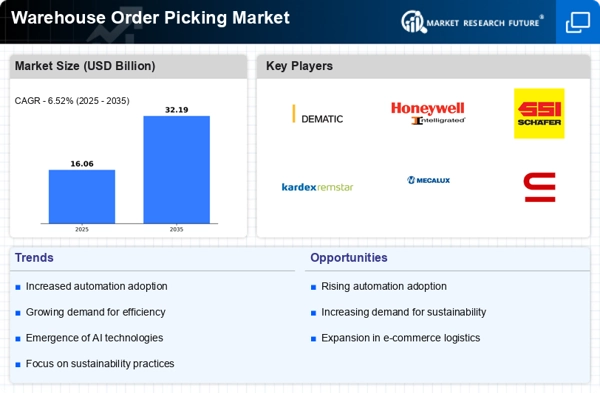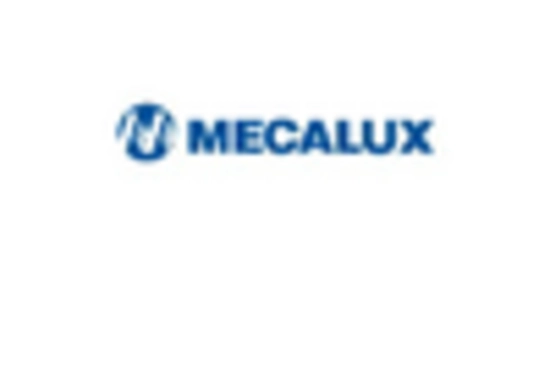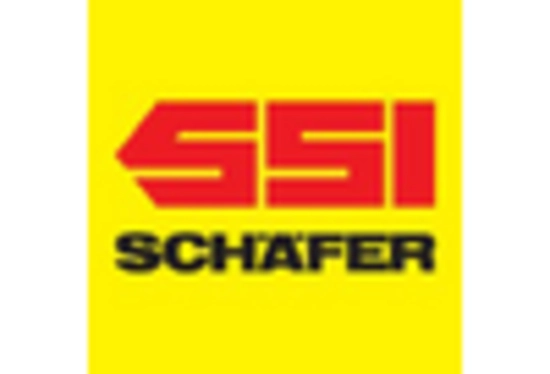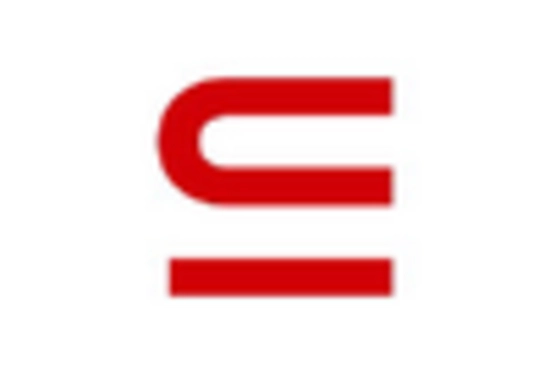Labor Shortages
Labor shortages are emerging as a critical challenge within the Warehouse Order Picking Market. As the workforce demographic shifts and fewer individuals enter the labor market, warehouses are facing difficulties in recruiting and retaining skilled workers. This situation is prompting companies to explore automation and technology-driven solutions to mitigate the impact of labor shortages. In 2025, the demand for warehouse workers is projected to exceed supply, leading to increased operational costs and potential delays in order fulfillment. Consequently, the Warehouse Order Picking Market is likely to see a rise in investments in automated picking systems that can operate efficiently with minimal human intervention. This trend underscores the importance of adapting to labor market dynamics to maintain productivity and competitiveness.
Sustainability Initiatives
Sustainability is becoming a pivotal focus within the Warehouse Order Picking Market, as companies seek to reduce their environmental impact. In 2025, there is a growing emphasis on eco-friendly practices, including energy-efficient technologies and sustainable packaging solutions. This trend is prompting warehouses to reevaluate their operations and implement strategies that minimize waste and carbon emissions. The Warehouse Order Picking Market is likely to witness an increase in demand for sustainable picking solutions that align with corporate social responsibility goals. Companies that prioritize sustainability may gain a competitive edge, as consumers increasingly favor brands that demonstrate environmental stewardship. This shift towards sustainability is expected to drive innovation and investment in green technologies within the warehouse sector.
Technological Advancements
Technological innovations are reshaping the Warehouse Order Picking Market, as companies increasingly adopt cutting-edge solutions to enhance operational efficiency. The integration of robotics, automated guided vehicles, and advanced software systems is becoming commonplace in warehouses. In 2025, the market for warehouse automation technologies is expected to grow significantly, driven by the need for improved accuracy and reduced labor costs. These advancements enable warehouses to optimize their picking processes, reduce errors, and increase throughput. As a result, the Warehouse Order Picking Market is likely to witness a shift towards more sophisticated picking systems that leverage technology to meet the demands of modern supply chains. The ongoing evolution of technology suggests that companies must remain agile to stay competitive in this dynamic environment.
Increasing E-commerce Demand
The surge in e-commerce activities has profoundly influenced the Warehouse Order Picking Market. As consumers increasingly prefer online shopping, the demand for efficient order fulfillment has escalated. In 2025, e-commerce sales are projected to reach approximately 6 trillion USD, necessitating advanced warehouse operations to handle the growing volume of orders. This trend compels warehouses to adopt innovative picking solutions to enhance speed and accuracy. Consequently, the Warehouse Order Picking Market is experiencing a shift towards automated systems and technologies that streamline the picking process, thereby improving overall operational efficiency. The need for rapid order processing and timely deliveries is likely to drive investments in advanced picking technologies, further shaping the market landscape.
Rising Consumer Expectations
Consumer expectations are evolving, placing heightened pressure on the Warehouse Order Picking Market to deliver faster and more accurate order fulfillment. In 2025, customers increasingly demand same-day or next-day delivery options, compelling warehouses to enhance their picking processes. This shift necessitates the adoption of advanced technologies and methodologies to meet these expectations. As a result, warehouses are investing in systems that facilitate real-time inventory management and efficient order processing. The Warehouse Order Picking Market is likely to experience a transformation as companies strive to align their operations with consumer demands, leading to increased competition and innovation in picking solutions. Meeting these rising expectations is essential for maintaining customer satisfaction and loyalty.

















Leave a Comment